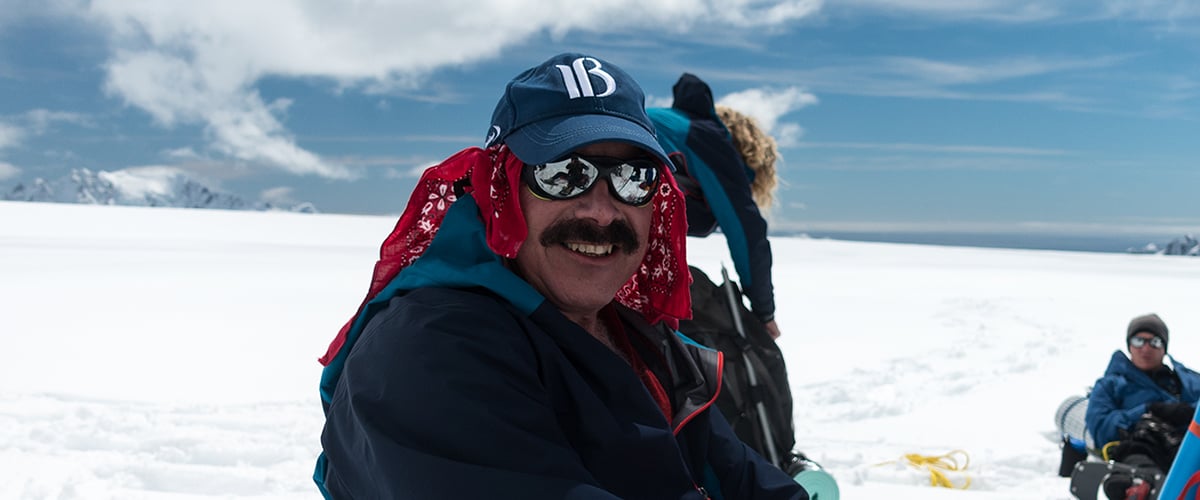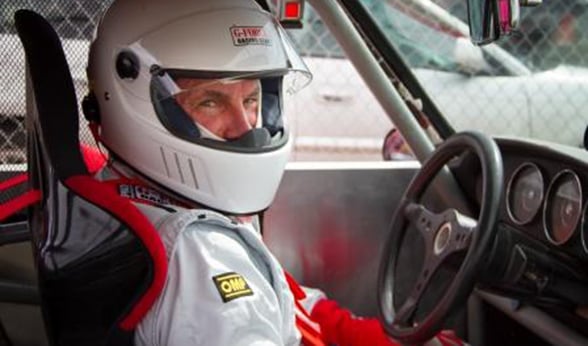 Richard Spritz, MD, making the Shackleton Traverse, a trek across South Georgia island.
Richard Spritz, MD, making the Shackleton Traverse, a trek across South Georgia island.
Geneticist Richard Spritz, MD, likes to be on the edge. Spritz, the Director of the University of Colorado School of Medicine’s (SOM) Human Medical Genetics and Genomics Program, loves the rush he gets from pushing his vintage Porsche 911 around a racetrack. He hikes in the Himalayas, and spent his most recent vacation trekking across a remote island, following the footsteps of famous Antarctic explorer Ernest Shackleton.
A career spent in a laboratory might seem less exciting, but not for Spritz. While he once was an accomplished mountain climber and survived two avalanches while backcountry skiing, he says his passion is not for taking risks—it is for the thrill of doing something new.
“I think that science is an incredibly adventurous thing. You’re always pushing beyond what’s known,” Spritz said. “I’m not an adrenaline junkie. Other people might call me that. I’ve just always been attracted to adventurous things.”
In Spritz’s eyes, there have been few bigger adventures in recent decades than the quest to understand genetics and use that knowledge to cure diseases. After more than 40 years, he still marvels at how his career unfolded, and how far the science has come.
Fateful decisions
Spritz, 66, is one of the world’s leading vitiligo researchers. For almost two decades, he’s been conducting groundbreaking work understanding the genetics behind the skin pigmentation disorder that causes white patches to appear on the face, body and hair. An estimated 50 million people worldwide have the condition, and Spritz has worked closely with international organizations such as the Vitiligo Society, the National Vitiligo Foundation and Vitiligo Support International.
Spritz didn’t set out to become a geneticist. Two decisions he made while he was still a self-described “brash young man” shaped the course of his career.
 Among Spritz's hobbies is racing his vintage Porsche 911
Among Spritz's hobbies is racing his vintage Porsche 911
Spritz is from Philadelphia, but he felt the mountains’ call at a young age, and he became an accomplished mountain climber in his youth. Successful ascents in the Alps, including the notoriously dangerous north face of the Eiger, earned him the respect of the climbing elite, and in the 1970s he was invited to join an expedition to climb Mount Everest.
Spritz declined because he was in medical school and did not want to disrupt his career. “I absolutely made the right choice,” he said.
“It’s mostly out of my system,” Spritz said. But he’s not through going on adventures, and last fall he hiked across South Georgia, an island near Antarctica. Peter Hillary and Jamling Tengzing Norgay, the sons of the first two men to climb Everest, were on the trek. They were filming a documentary for National Geographic about Shackleton, who had to cross the mountainous island to rescue his stranded crew. In the company of climbing royalty, it was natural to think about Everest, but Spritz saw the risk.
“I’m 66 years old. While I’m not like most 66-year-olds, I know I could get high enough to get into real trouble,” Spritz said. Now, he gets his thrills through amateur auto racing, which he points out is far safer than climbing or extreme skiing. His next trip will be to the Himalayas for another trek.
Spritz made his second career-defining decision “literally one day while walking down the street,” he said. He had planned to become a surgeon and had made arrangements to start down that path, but realized genetic research was a better fit for someone seeking to push scientific boundaries.
“I was incredibly lucky, because I did that at exactly the right moment in history, at the beginning of recombinant DNA research,” Spritz said. “I was lucky to get in on the ground floor.”
It led to a fruitful career. In the late 1970s, researchers were just discovering how to isolate, identify and sequence human genes. The biggest early discovery Spritz was part of was finding and sequencing a mutation that affects hemoglobin, the molecule that carries oxygen in the blood. It was the first time a mutation had been sequenced.
Still making discoveries
[perfectpullquote align="right" cite="" link="" color="" class="" size=""]“Despite the fact that vitiligo has been known for hundreds of years, there’s never been a drug developed for it,” Spritz said. “That might change in the near future.”[/perfectpullquote]
Spritz has not stopped researching—or making discoveries. In October, Spritz and his lab published a paper in Nature Genetics finding 23 genes linked to susceptibility for vitiligo. The lab tested 4,680 people with the condition and 39,586 control cases. The study attracted the attention of pharmaceutical companies, which Spritz said is good news because a medication to treat vitiligo could be a major step forward from the current steroid and ultraviolet light treatments.
“Despite the fact that vitiligo has been known for hundreds of years, there’s never been a drug developed for it,” Spritz said. “That might change in the near future.”
Much more research would be needed before a drug could be developed, and then it would have to go through rounds of safety and efficacy testing. Spritz said enough work has been done that complex relationships between genes “are coming together in a way that kind of makes sense,” which has allowed vitiligo researchers to “leap frog” ahead faster than Spritz expected.
People with other conditions might benefit as well. In the mid-2000s, Spritz established that vitiligo was an autoimmune disease, in which the body attacks its own skin pigmentation cells. Research has shown people susceptible to vitiligo have increased odds of other autoimmune conditions such as Type I diabetes, rheumatoid arthritis and Addison’s disease. Vitiligo research could lead to progress understanding those conditions, and vice versa.
That would be the next chapter in an ongoing scientific adventure.
“It’s amazing to me how far we’ve come, how naïve we were and yet how prescient we were at the same time,” Spritz said. “We are asking and answering the kinds of questions we couldn’t have imagined when I was a student. I think that’s incredibly inspirational – and we’ve hardly started.”




